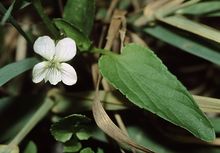Viola elatior
| Fen violet | |
|---|---|

| |
| Scientific classification | |
| Kingdom: | Plantae |
| Clade: | Tracheophytes |
| Clade: | Angiosperms |
| Clade: | Eudicots |
| Clade: | Rosids |
| Order: | Malpighiales |
| Family: | Violaceae |
| Genus: | Viola |
| Species: | V. elatior
|
| Binomial name | |
| Viola elatior Fr.
| |
| Synonyms | |
|
List
| |
Viola elatior, the fen violet,[1] is a species of violet native to central and northern Europe and northern Asia.[2] In the British Isles it is very rare, occurring in a few fens in England and near the western coast of Ireland.
The violet is also known as viola persicifolia and viola stagnina.[3]
Description
[edit]Viola elatior grows to a height of 10 to 30 cm (4 to 12 in) from a creeping rhizome, with narrow, triangular leaves 7 to 15 mm (0.28 to 0.59 in) across. The flowers are produced in late spring to early summer, 10 to 15 mm (0.4 to 0.6 in) diameter, pale bluish or yellowish-white with a short, greenish or yellowish spur. The petals are rounded and broad in relation to their width.[4][5]
Distribution and habitat
[edit]Viola elatior occurs in native to central and northern Europe and northern Asia. Its habitat is confined to very local damp, lime-rich places, in long herbage (fens and limy marshes).[4]
The plant is fussy about where it grows; seeds germinates in the spring on moist bare patches of base-rich peaty soil, but the seedlings only become established if the soil surface becomes drier. Most seeds germinate in close proximity to the parent plant so dispersal is limited. Habitat disturbance may cause the violet to disappear from a former habitat, but the seeds are very long-lived and new plants sometimes appear many years later.[4]
In the British Isles, it is rare, confined to eastern and northern England and damp hollows with limestone soils in western Ireland. Efforts are being made to re-introduce it to newly suitable habitat in the Fens as part of the Great Fen Project.[6][7] It occurs at a few locations in Northern Ireland, on rocky limestone lake shores around Upper Lough Erne and in turloughs or ephemeral pools around Fardrum, in County Fermanagh, and because of its rarity there, it is listed as a Northern Ireland Priority Species.[4]
References
[edit]- ^ BSBI List 2007 (xls). Botanical Society of Britain and Ireland. Archived from the original (xls) on 2015-06-26. Retrieved 2014-10-17.
- ^ "Viola elatior Fr. | Plants of the World Online | Kew Science". Plants of the World Online. Retrieved 2023-09-27.
- ^ "Viola persicifolia | fen violet /RHS".
- ^ a b c d Forbes, Ralph. "Viola persicifolia – fen violet". Northern Ireland Priority Species. Retrieved 11 March 2020.
- ^ McClintock, D.; Fitter, R.S.R. (1956). Fen violet. The Pocket Guide to Wild Flowers. p. 25.
- ^ "Fen violet". The Great Fen. Bedfordshire, Cambridgeshire, Northamptonshire Wildlife Trusts. Retrieved 11 March 2020.
- ^ "Viola persicifolia". Online Atlas of the British and Irish Flora. Retrieved 11 March 2020.
